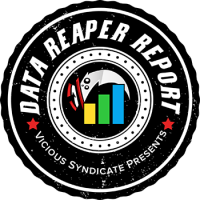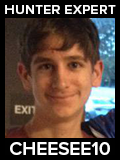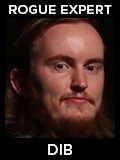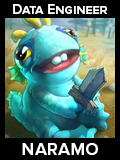
Welcome to the 144th edition of the Data Reaper Report! This is the first report following the launch of the Doom in the Tomb event.
Our Data Reaper Project, including the Data Reaper Live has 3,800 active contributors and we thank them wholeheartedly. Contributing to the Data Reaper project through Track-o-Bot or Hearthstone Deck Tracker (recommended) allows us to perform our analyses and to issue the weekly reports. Without the community’s contribution, there would be no project. Contributing data is very easy and takes a few simple steps, after which no other action is required. If you enjoy our content and would like to make sure it remains consistent and free – Sign Up!
Quick Links
Class/Archetype Distribution | Class Frequency | Matchup Winrates | vS Power Rankings | vS Meta Score | Class Analysis & Decklists | Meta Breaker of the Week | How to Contribute | Credits
Number of Games
| Overall | 30,000 |
| Legend | 3,000 |
| Ranks 1-4 | 10,000 |
| Ranks 5-9 | 13,000 |
| Ranks 10-14 | 3,000 |
Class/Archetype Distribution
[TABS_PRO id=27990]
Class Frequency
[TABS_PRO id=27991]
Data Reaper Update: New Deck Format
Starting with this report, every deck we’re featuring is now presented in a new format that labels cards as Core, Flex or Tech. Click on a link to a decklist to see how it looks and you’ll quickly understand.
Core describes a card we’ve found to be very important to the deck’s game plan, and cutting it in the current meta would not be optimal. We don’t recommend replacing core cards, unless something drastic changes in the meta.
Flex describes a card we’ve found to perform well enough to be included in the deck, but it isn’t extremely essential. We’ve identified scenarios where it would be less useful, and this card would be a good candidate to make way for another card when the need arises.
Tech describes a card we’ve found to not be quite good enough to be included in the main deck, but it’s situationally strong. We’ve identified scenarios in which it would be useful, and it could become a stronger choice in the future. These cards are not included in the deck code.
A deckbuilder with these features will be available to the community soon. We hope you find these new features useful!
Class Frequency Discussion
Shaman looks out of control. The re-introduction of Evolve back to Standard format has ignited the class and it’s currently burning down the field like a wildfire. Both Quest Shaman and Aggro Shaman have incorporated the Desert Hare/Evolve combo on their climb to the top of the meta. From rank 4 onwards, Shaman crosses 30% popularity, and Quest Shaman alone is more popular than any other class. At legend, Aggro Shaman also becomes more popular than any other class. Shaman’s play rate peaks at Rank 1, where it sits at 40%. We’re getting flashbacks to Druid at the launch of Knights of the Frozen Throne and the first Shamanstone era during One Night in Karazhan.
Resurrect Priest has surged in play. N’Zoth, Sylvanas, Ragnaros, and Thaurissan have all joined the ranks to significantly boost this archetype’s late-game potential. Combo Priest hasn’t received any new cards to utilize, so its play rate has severely declined. However, trends at higher levels of play show Resurrect Priest falling back to earth, while Combo Priest is beginning to raise its head once again.
Most Hunter archetypes have almost entirely disappeared, with Highlander Hunter looking like the sole survivor in the current meta. We found it possible to reliably split Highlander Hunter between the Secret variant running Subject 9 (“Secret-HL”), and the more aggressive Mech variant (“Mech-HL). What’s the best approach? You’ll find out here.
Murloc Paladin looks dead in the water. In its place, Highlander Paladin has emerged to become the most popular archetype within its class. The large majority of Highlander Paladins are aggressive, secret builds running Mysterious Challenger and Avenge. Holy-Wrath Paladin has stuck around with its modest representation.
Quest Druid has gone through much experimentation with the launch of the event. Its most popular variant is now the Malygos build, while Nomi is relatively uncommon. We also see fatigue variants that run Baleful Banker to infinitely chain Elise alongside Kun the Forgotten King. This article will address what’s the best variant.
Rogue looks fairly diverse, with all sorts of decks showing up on the radar. We have the familiar Pirate Aggro Rogue, which had been present in the meta before the event’s launch. Tempo Rogue has emerged, with builds resembling Lackey Rogues from the second half of Rise of Shadows. Quest Rogue has stuck around, and Deathrattle Rogue is seeing play after the introduction of N’Zoth.
Mage has gone through a huge spike in play thanks to Flamewaker’s grand entrance to the format. Cyclone Mage builds utilizing this powerhouse card from Blackrock Mountain have seen widespread play, while interest in Highlander Mage has also increased with builds running the N’Zoth win condition.
Warrior has fallen off hard. Whether this is a result of the class losing power or just not looking very enticing to try out is a question we’ll answer later. Many Control Warrior builds have added the N’Zoth win condition to their top-end while cutting the Taunt package. Aggro Warrior has been fairly neglected in terms of experimentation.
Warlock sits at the bottom. N’Zoth has also been a relevant player here, with Warlock players testing full Control builds utilizing him as the centerpiece. Zoo Warlock remains the most popular Warlock deck, but that doesn’t say much: from rank 4 onwards, it’s less than 2% of the field.
[TABS_PRO id=27992]

[TABS_PRO id=27993]
vS Meta Score
[TABS_PRO id=27994]
vS Power Rankings Discussion
To the surprise of absolutely no one, Shaman is very, very strong. It’s clearly the best class in the game once you reach rank 4, where Quest Shaman exhibits a perfect meta score of 100 (highest play rate and win rate). Quest Shaman’s overall matchup spread looks clean. It has only two reliable counters in the current meta: Combo Priest and Holy-Wrath Paladin.
For the first couple of days of the patch, Shaman’s win rate reached 55% and we thought we were about to experience one of the most oppressive classes ever. However, things have relaxed since then, and we suspect that Shaman might be toned down to some degree by upcoming meta trends. Several decks are also improving their performance against it. Shaman should remain very powerful and very popular. Things are just unlikely to get worse.
Combo Priest is extremely underplayed considering its power level, but we think its low play rate is temporary. The deck is in pole position to break the meta once again, offering the best solution to the current dominance of Quest Shaman.
However, Combo Priest cannot bring the entire Shaman class down on its own, because Aggro Shaman performs very well against it. Should Combo Priest rise, there might be a shift in play towards Aggro Shaman, leading to an effective response against Priest that would keep Shaman on top. It’s very difficult to consistently beat both of the dominant Shaman decks, so in a way, they reinforce and protect each other. Control Warrior may be a very reliable counter to Aggro Shaman, for example, but it struggles to survive through Quest Shaman’s late-game prowess.
While Combo Priest is underplayed, Resurrect Priest might be a little overplayed. Its matchup spread looks good on the surface, until you find the critical red square of Quest Shaman. This matchup is very painful, especially at higher levels of play. Still, Resurrect Priest is stronger than it used to be and very competitive. We highly recommend not running the quest. It’s a trap that’s also weighing down its current ladder win rate to some degree.
Subject 9 is still the way to go for Highlander Hunter. The Mech build performs worse in several key matchups, including Shamans, which should be enough to convince you on what’s better! Secret Highlander Hunter is a top tier deck with very few weaknesses. The prospect of its strongest counter potentially declining (Resurrect Priest) makes this deck’s near future look even brighter.
Paladin is here to stay. Mysterious Challenger has been a big boost to Highlander Paladin, and the deck looks significantly stronger than it did before the event. Holy-Wrath Paladin is the only deck that looks capable of beating both Aggro Shaman and Quest Shaman, but its matchup spread is checkered with problems (such as Quest Druid with Kun). It might be too narrow of a “Shaman counter” to see consistent success. Perhaps it could see use in a high legend meta overloaded with Shamans.
Wait, is Quest Druid Tier 3? Really? Well, the data is telling a lie here. The reason why Quest Druid’s win rate is so low is thanks to the Malygos variant’s popularity. It’s just bad, and Emperor Thaurissan hasn’t made a worthwhile impact to change things. We’ve looked at the Nomi build, which is far less popular, and we can confidently say that it’s far, far better than what the numbers show for the archetype at the moment. The player base just needs to drop Malygos and go back to Nomi, or even try the Baleful Banker build, which also shows some promise. We estimate that the difference in ladder win rate between Malygos and Nomi is around 3%, which is massive. It’s the difference between lingering at Tier 3 and dominating at Tier 1.
Aggro Rogue might be losing its spot as top dog of its class to the slightly slower and more resource-centric Tempo Rogue. Tempo Rogue has a more well-rounded matchup spread, and it stands a better chance against Rogue’s natural counters: Druid and Warrior. We’re not impressed with what we’ve seen so far from Quest and Deathrattle Rogue, though.
Warrior’s popularity might have crashed, but the class is not actually in any trouble, and we expect it to recover. The N’Zoth experiment in Control Warrior has been unsuccessful. Much like Malygos in Druid, it’s only making the deck worse. Aggro Warrior’s matchup spread is nearly as impressive as it was before, with the emergence of Resurrect Priest hampering it a bit, but it retains decent matchups into Combo Priest and Shamans.
Cyclone Mage looks absolutely fraudulent. It’s incredible that a deck with Flamewaker and Mana Cyclone has a 40%-ish win rate, but here we are. Highlander Mage doesn’t look like it’s making any breakthrough either, so the Mage class looks in a pretty bad spot. At least it’s not Warlock.
Warlock, unfortunately, is actually Warlock. While we cannot show this in the Power Ranking table, we’ve found that Control Warlock and Quest Warlock are the two best decks in the game if you’re interested in climbing from rank 1 to rank 5. Zoo Warlock has been kicked out to Tier 4 by the rising power of Shamans. Guess that’s why Renounce Darkness was brought in? Blizzard is telling us to play other classes.
Class Analysis & Decklists
Druid | Hunter | Mage | Paladin | Priest | Rogue | Shaman | Warlock | Warrior
Shaman is the biggest winner of Treasures from the Tomb. Thanks to the addition of Evolve and its oppressive interactions with Desert Hare and Mogu Fleshshaper (a card that was already extremely powerful), the class has become an absolute powerhouse and is dominating the current meta.
There are very few decks that can deal with a turn 4 Evolve, and no deck can reliably beat it. Evolve has given Shaman the most consistently unfair turn in the format, and it is particularly crippling against initiative-focused decks that have no choice but to develop minions into a Mogu Fleshshaper. Desert Hare is far stronger than old Doppelgangster because it comes down two turns earlier, making it less likely for any deck to have a consistent answer to it.
Quest Shaman has the added bonus of a scalable Hare/Evolve combo. Upon completion of the quest, Shamans can use their hero power to make their Hare/Evolve combo even bigger from turn 6. This has given Quest Shaman better matchups into slower decks, while an earlier turn 4 Hare/Evolve combo still provides a game-winning scenario in any matchup. To fit Hare/Evolve into Quest Shaman, we cut some of the slower cards in the deck: Former Champ, Giggling Inventor, and Bog Slosher. The latter is particularly overrated at the moment.
Aggro Shaman is “evolving” into a combo-ish deck that looks to make one big swing turn rather than incrementally developing the board, and our insights regarding the performances of some of its cards support this idea.
Underbelly Angler is a mulligan trap that just isn’t good enough. Thing from Below is slow and requires too much support. Spirit of the Frog is extremely underrated, and few players are running two copies of the card at the moment. We think it’s core to the deck and should be fully built around, because it allows us to draw into our power spikes more consistently. Lightning Bolt is cut because it reduces our chances of drawing Evolve from Spirit of the Frog. Plan for the power spike (Hare/Evolve, Thunderhead/Overload) rather than curving out, and your results will improve.
Murloc Shaman is still a strong deck, but in a class that has become so powerful, it’s being completely overshadowed. Evolve has anti-synergy with the deck because you’re usually looking to buff your tribal minions, so Murloc Shaman stays the same as it was before the event. It’s still performing well, but is there a reason to play it over Aggro or Quest Shaman? Not really, so it’s in a weird spot.
With the introduction of the new Wild cards, Combo Priest has fallen in popularity as it hasn’t taken advantage of any of the cards introduced.
However, Combo Priest’s matchup spread is still very impressive, and it has proven to be one of the only reliable answers to the new Evolve Quest Shaman. While this matchup has become more difficult due to the introduction of Hare/Evolve, Priest is still very much favored. However, Priest struggles in the Aggro Shaman matchup, since this opponent has plenty of removal tools to push the Priest off the board, rendering it largely ineffective.
A deck that has risen in popularity and win rate after the patch is Resurrect Priest. With N’Zoth, Sylvanas, Thaurissan, and Ragnaros, this archetype has plenty of new juicy targets to resurrect or summon with Zerek’s Cloning Gallery. The build we’ve featured in our theorycrafting article has taken over ladder after several players had success with it at top legend ranks. We recommened not running the quest, as it is completely unnecessary with the powerful late-game already available to this archetype. The quest will only make your survivability in the early game less consistent.
Note that while Resurrect Priest is a lot stronger than it used to be, and its matchup spread looks quite good on the surface, it struggles against Quest Shaman. The prevalence of this difficult opponent prevents the deck from truly taking off, and it’s not one of the best decks on ladder as a result.
Always underestimated initially, Secret Highlander Hunter continues to find ways to stay at the top tier of the meta. While the matchup against Shaman has become more difficult due to the addition of Hare/Evolve, the deck’s new late-game upgrades have given it a boost in slower matchups such as Quest Druid and Control Warrior. Ragnaros has been a good addition, while Call of the Wild is straight-up bonkers alongside Zul’jin, as we’ve expected it to be. The featured build was taken straight from our theoyrcrafting article, and it’s the most common build on ladder right now.
The Subject 9 variant also remains the best Hunter build going forward. We’ve seen Mech Highlander builds popping up, but they’ve proven to be largely inferior, and certainly weaker than they were before the patch. We also don’t expect to see non-Highlander Mech Hunter returning, as it’s looking even weaker in the current format.
Hunter seems to be solidifying into the same dominant archetype that has seen so much success throughout Saviors of Uldum, with all other Hunter decks fading away in the face of a format that’s grown in power.
The Paladin class has changed quite dramatically after the patch, with some of its archetypes nearly disappearing, while one has gained notable strength.
Mysterious Challenger and Avenge initially sparked experimentation with Secret Paladin, but this archetype quickly disappeared to make way for a Secret Highlander Paladin deck. It is currently the most promising and common variant of Highlander Paladin, elevating it to a strong win rate after it was previously lingering in mediocrity.
The featured build is pretty straight forward, and looks to combine strong on-curve plays with significant drawing power. The archetype usually performs well against decks that don’t challenge its control of the board in the early game, such as Control Warrior and Quest Druid. It has a more difficult time in faster matchups.
Holy-Wrath Paladin is the 2nd most notable deck within the class, incorporating Emperor Thaurissan into its build. It has decent matchups against Shamans, which is its strongest selling point, but terrible matchups into many other decks, making its performance on ladder unimpressive. Its matchup against Quest Druid, for example, has become very difficult due to the introduction of Kun.
Murloc Paladin has almost completely disappeared for a good reason: its win rate has nosedived throughout ladder, and it is greatly outclassed by Highlander Paladin. Its matchup against Shaman has become horrendous due to the Hare/Evolve combo, which comes down a turn earlier than Tip the Scales.
The introduction of Emperor Thaurissan has encouraged players to give the previously inferior Malygos variant of Quest Druid another go. After carefully looking into the archetype, our verdict is pretty clear. Malygos is still the inferior variant, by far, compared to the Nomi build. The popularity of Malygos in the first week of the patch was so detrimental to Quest Druid’s win rate that it has sunk into Tier 3. Make no mistake: this week’s results do not reflect Quest Druid’s real potential.
We estimate that the Nomi build, which is relatively uncommon at the moment, is one of the strongest decks in the game. Another viable alternative that is stronger than Malygos is to run Baleful Banker instead of Nomi, chaining an infinite combo in which we shuffle Elise while copying and re-playing Kun.
Regardless of variant, Kun the Forgotten King has been a tremendous addition to Quest Druid, and has quickly become one of the best cards in the deck. A 0 mana 7/7 that gives you 10 armor is pretty crazy, and things become pretty disgusting when you add Floop and Elise to the mix. Just play it.
Much like before the patch, Rogue looks competitive, though it isn’t one of the most dominant classes in the format. Swashburglar has proven to be a strong addition for all of Rogue’s notable archetypes.
Aggro Rogue’s lightning pace gives it the greatest chance of blowing out Combo Priests and Quest Shamans before they’re able to find their power spikes. The deck’s weakness lies in its matchups against Warrior and Druid, as we’ve discussed many times before.
Tempo (Lackey) Rogue seems to have successfully emerged as a viable, and likely better alternative to Aggro Rogue. The biggest benefit of running this deck over Aggro Rogue is that its matchups into Warrior and Druid are better because it has better late game longevity and it isn’t forced to go all-in. Therefore, Tempo Rogue is a less polarizing deck, which makes its performance on ladder more consistent in the current meta.
Quest Rogue is hardly competitive. The problem with slower Rogue decks is that they give more time for Shamans to find their Evolve blowout turn, a turn that Rogue simply cannot handle due to its lack of AOE. Quest Rogue also tends to give Quest Druid more time to stabilize, which is a big no-no.
Deathrattle Rogue has seen quite a bit of experimentation, but so far, it looks like it belongs in the dumpster. We couldn’t properly refine a list we were comfortable with. Maybe next week.
Cyclone Mage has received a lot of hype in the first couple of days of the patch, with the promising addition of Flamewaker looking to complement the combo of Sorcerer’s Apprentice and Mana Cyclone. Unfortunately, all new iterations of this archetype have been performing terribly and they will likely disappear within the next couple of weeks. There’s probably nothing to see here.
Meanwhile, Highlander Mage has emerged in the familiar Tier 3, which is where it’s mostly been sitting after Luna’s Pocket Galaxy got nerfed. N’Zoth is a pretty good addition, giving Mage a more reliable win condition than the Big-Spell package. This gives the deck stronger matchups into Control Warrior and Quest Druid. However, the deck doesn’t seem to be capable of consistently beating Shaman, once again highlighting the weakness of the N’Zoth win condition against Mind Control Tech.
Warrior had a week of mixed results, with its play rate falling off after the introduction of Doom in the Tomb. However, there is a good reason to believe that this setback is temporary for both of its primary archetypes, and the class could have a big role to play in the evolving Shaman meta.
Aggro Warrior has been greatly neglected, with most players disregarding the deck. Based on its performance, this is very likely to change. Aggro Warrior’s matchup spread is still fantastic, and it is the only deck in the current meta that doesn’t have a losing matchup against either Aggro or Quest Shaman. One of its more difficult matchups (Resurrect Priest) should decline in the next couple of weeks too, so we think there’s a chance that it will get stronger.
Control Warrior has been relatively struggling for two main reasons. The first is the prevalence of greedy decks that aren’t particularly good but happen to perform well against removal-focused game plans. Control Warrior is an archetype that has historically been effective at beating powerhouse aggressive decks, yet falls prey to random memes that you wouldn’t normally take seriously. Once these “bad decks” fade away, and the meta becomes more competitive, the field should also become more favorable for the archetype.
The second reason is that Control Warrior has seen vast experimentation with N’Zoth, which makes the deck so much worse. The pre-patch Taunt build performs significantly better, and once it becomes the popular variant again, we expect to see Control Warrior’s win rate climb. It is also important to note that Control Warrior is the biggest available counter to Aggro Shaman, which is one of the best decks in the game. While the matchup against Quest Shaman has become more difficult, Control Warrior’s standing in the meta might be boosted by a rise in Combo Priest.
Warlock has experienced an infinite chain of failures this week. All experimentation with late-game strategies in the class have fallen flat. N’Zoth hasn’t been enough to make things any better, and both Control Warlocks and Quest Warlock sit deep in the dumpster.
But to make matters worse, the last bastion of competitiveness in the class has crumbled. Zoo Warlock has seen the field grow stronger, and it now stands little chance against the Shaman onslaught, with Imp Gang Boss only providing a small upgrade.
Gul’dan might be down and out of the format. If you want to find him, he’ll be playing SN1P-SN4P in Wild until December.
Everyone knows Shaman is good, but ladder is still sleeping on the power level of Combo Priest. Meta trends that are most likely to occur within the next couple of weeks is a rise in Combo Priest to counter Quest Shaman (the current best deck in the game), and a shift to Aggro Shaman to respond to Combo Priest. There are other decks in the mix that we think are very promising and can change the landscape, but playing Combo Priest is the best way to climb ladder right now.
Unless you just want to play Shaman. Then you just play Shaman.
- You don’t read the Data Report: Quest Shaman
- You read the Data Report: Combo Priest
- You read the Data Report but want to mind game other readers of the Data Report: Aggro Shaman
Our Data Reaper Project, including the Data Reaper Live has 3,800 active contributors. Without them, this project would not be possible, so we’d like to thank all of our contributors for their help.
Preparing our weekly article requires a significant amount of time and effort from many individuals. We would like to wholeheartedly thank our current Patreons, whose generous donations help us fund computing and server costs.
vS Gold is a new membership plan aimed to support our efforts towards improving our content and data analysis while receiving some bonuses and extra features.
Tier 3+ Patrons
Special thanks to Leo G, Aaron B, Jed M, Drew M, Alan J, Eric L, Zolstar, Sean H, Steve F, Andrew N, NObdy, Mark S, Alonso P, msKang, James Y, PinkMageDiaries, Je-ho, Ziqiao Y, Stephen H, William H, Patrick L, and 1RiceBowl1 for supporting us for the month of October.
Contributors
Here are all the people that participated in bringing you this edition of the vS Data Reaper Report:






























Did… did you read anything on this page?
What about quest paladin, quest priest? They are bothe extremely powerful.
How about Flamewalker mage?